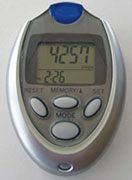
TUESDAY, July 24 (HealthDay News) — Many people say they want to get out and walk or exercise more, but following through is another matter. Now, a study suggests that simply wearing a pedometer can help boost walking rates.
The study of more than 300 New Zealand seniors found that weekly walking times nearly doubled when they wore the devices.
“Use of pedometers, as a mechanism to monitor physical activity, was beneficial to older adults as they improved their levels of activity,” said study lead author Gregory Kolt, head of the School of Science and Health at the University of Western Sydney in Penrith, Australia.
“Pedometers allowed users to check their progress throughout the day against activity goals they had set for themselves,” Kolt said.
The study, published in a recent issue of the Annals of Family Medicine, tracked walking rates for over a year among 330 relatively non-active people aged 65 or older.
At the time of the study’s launch in 2006, all of the participants were deemed healthy enough to engage in physical activity, including walking, but most admitted they got little regular exercise.
Participants were randomly separated into two groups: one group received pedometers to track their step-by-step movements, and the other group did not.
All were then asked to follow New Zealand’s so-called “Green Prescription” for physical activity — a government-funded initiative aimed at getting people to engage in 30 minutes of moderate physical activity each day.
Participants were encouraged by both a doctor and in regular telephone counseling sessions to get active via leisure-time walking.
Over the course of a year, both groups of seniors boosted their activity levels significantly, the researchers found. However, those who had been given pedometers increased their average weekly walking time by almost twice as much as those who didn’t have pedometers — about 50 minutes per week for pedometer-wearers versus 28 minutes for those without the devices.
While neither group saw any change in their weight (as measured by body mass index or BMI), both groups did experience significant improvements in blood pressure, the researchers noted.
How did pedometers work to boost walking rates? According to Kolt, wearing the device apparently “allows users to see how much physical activity they are accumulating through their general daily routines,” upping the odds they’ll stick with the program.
Pedometers’ cheap price tag may also make them an ideal component of public health efforts aimed at boosting exercise habits, said Kolt, who is also affiliated with the Centre for Physical Activity and Nutrition Research at the Auckland University of Technology in New Zealand.
One expert in the United States agreed. David Bassett Jr. is co-director of the Obesity Research Center and a professor of health and exercise science in the department of kinesiology, recreation, and sport studies at the University of Tennessee in Knoxville. He said the New Zealand research is “consistent” with prior studies.
“In general, researchers have found that pedometer-based exercise prescriptions elicit greater changes in walking than equivalent time-based exercise prescriptions,” he said. “The study shows that pedometers can be used in a minimal contact, cost-effective manner within health care systems, to encourage healthy lifestyles.”
More information
For most on boosting your daily exercise rate, head to the U.S. National Institute on Aging.

